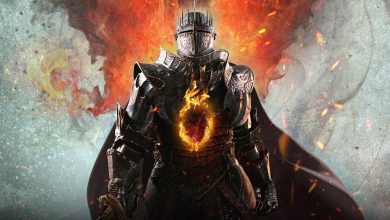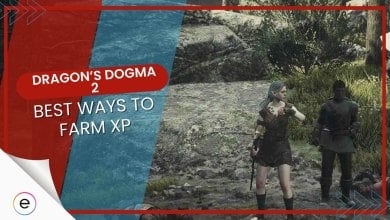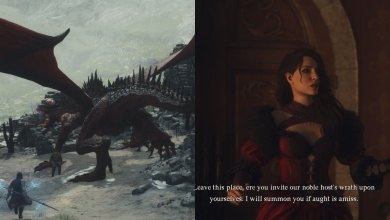Players have been eagerly waiting for Capcom’s ARPG ever since it was announced back in June 2022. Now that the wait’s over and the game is finally in my hands, I feel it should have cooked a bit more in the oven. The unpolished state of the game, coupled with weird game-crashing bugs really tarnishes the experience for me, as it has been for other players.
However, the hope isn’t all lost yet as the game’s performance can still improved after a bit of tweaking. So that’s exactly what I did and came up with the the best Dragon’s Dogma 2 settings that you can also use to optimize performance.
I tested the game on the following specifications:
- OS: Windows 11 Pro 23H2
- System: Lenovo Legion 7i Laptop
- CPU: Intel i7-11800H
- GPU: NVIDIA RTX 3070 8GB
- RAM: 32GB DDR4
- Storage: Samsung 1TB SSD Gen 4
After testing, I’ve uncovered that the following settings are the most taxing on your performance:
- Ray Tracing
- Screen Space Reflections
- Mesh Quality
- Grass Tree Quality
- Resource-Intence Effects Quality
- Shadow Quality & Contact Shadows
- In general, Dragon’s Dogma 2 performs very poorly on average PC hardware as it’s another case of “made for next-gen PCs” while ignoring the current-gen ones. While it does perform well for some, most players are left complaining about the FPS drops and low performance across the board.
Now that you’ve gotten an idea of how bad the port is, let’s try and optimize the in-game graphics settings for Dragon’s Dogma 2 and improve performance as much as we can.
Best Dragon’s Dogma 2 Settings Summary
Here’s a quick summary table of my recommended settings for Dragon’s Dogma 2:
| Setting | Preset |
|---|---|
| Graphics Quality | Custom |
| Display Mode | Fullscreen |
| Screen Resolution | Native |
| Refresh Rate | Maximum |
| Frame Rate | Variable |
| Vertical Synchronization | OFF |
| Dynamic Resolution | OFF |
| FidelityFX Super Resolution 3 | Balanced (If AMD Or Nvidia Non-RTX GPU) |
| DLSS Super Resolution | Balanced (If Nvidia RTX GPU) |
| DLSS Nvidia Reflex Low Latency | ON |
| Upscale Sharpness | Your Preference |
| Rendering Mode | Interlaced |
| Image Quality | 50% |
| Ray Tracing | Off |
| Ambient Occlusion | SSAO |
| Anti-aliasing | TAA + FXAA |
| Screen Space Reflections | OFF |
| Mesh Quality | Mid |
| Texture Filtering | High (ANISO X8) |
| Texture Quality | High (1 GB) |
| Grass/Tree Quality | Low |
| Resource-Intense Effects Quality | High |
| Shadow Quality | High |
| Shadow Cache | ON |
| Contact Shadows | ON |
| Motion Blur | OFF |
| Bloom | ON |
| Depth Of Field | ON |
| Lens Flare | OFF |
| Lens Distortion | ON + Chromatic Aberration |
| Subsurface Scattering | OFF |
| Motion Quality | Low |
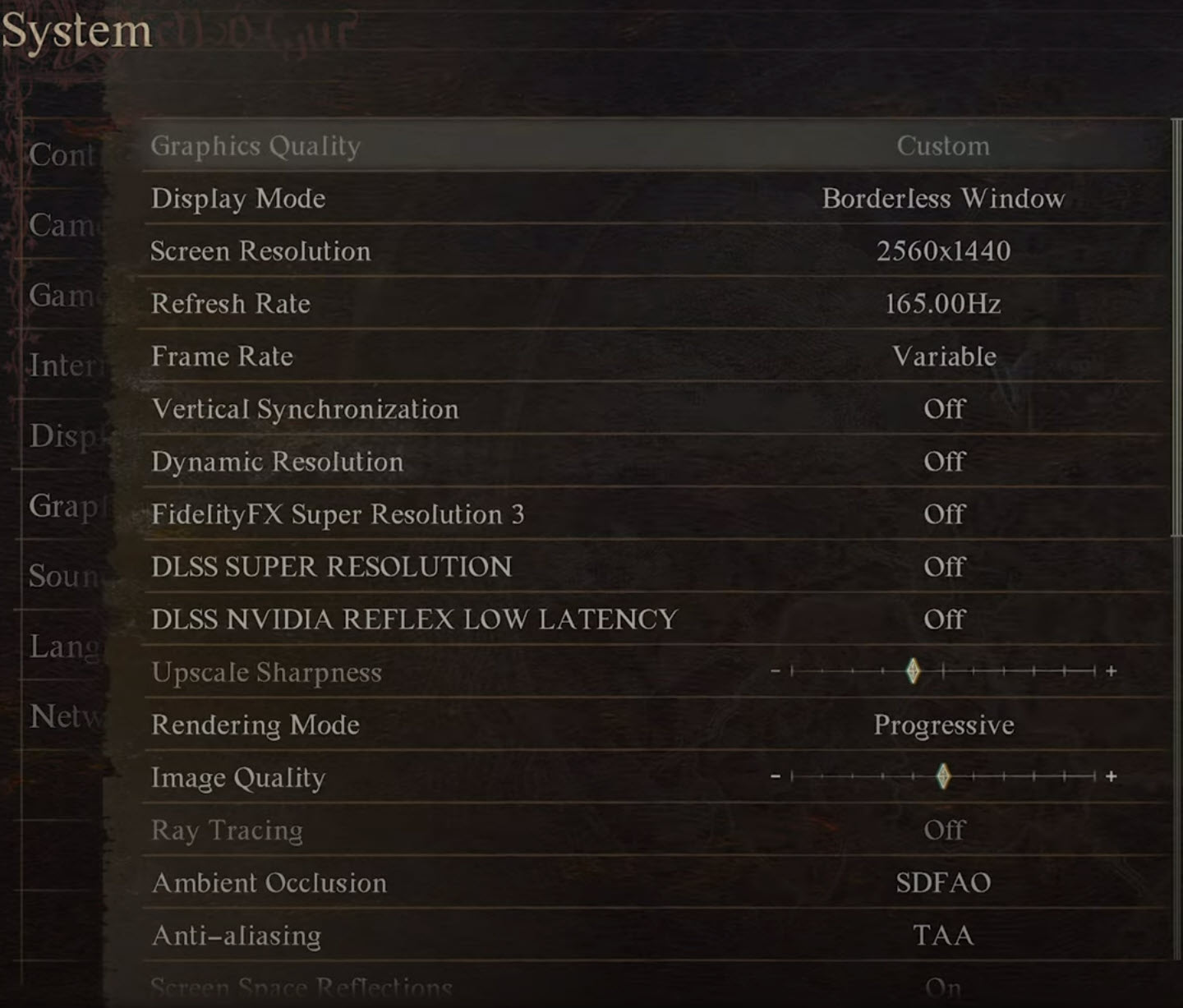
Graphics Quality: Custom
We’ll be tweaking individual graphics settings, hence the Graphics Quality preset will be set to Custom.
Display Mode: Fullscreen
Although some players prefer using Borderless Fullscreen, exclusive Fullscreen is the option that’s best in terms of attaining higher performance.
Screen Resolution: Native
Set your native display monitor resolution here as anything lower will simply make objects blurry. However, if you’re really scraping for performance increase then you may set it to 1 to 2 increments lower and raise the sharpness.
Refresh Rate: Maximum
Set the maximum amount of refresh here that your monitor supports for the best experience.
Frame Rate: Variable
It’s best to avoid capping your framerate and instead set it to variable to let your GPU freely push out the number of frames it can at any given instance.
Vertical Synchronization: OFF
VSync will only introduce more input latency into your gameplay, especially if you’re already experiencing bad performance. Best set it to off.
Dynamic Resolution: OFF
Dynamic Resolution will only degrade the game’s visual quality when your framerate takes a dip. Although it’s a helpful feature on paper, it doesn’t work properly half of the time only making everything mushy and low-res.
FidelityFX Super Resolution 3: Balanced (If AMD Or Nvidia Non-RTX GPU)
AMD’s FSR 3 is an utterly amazing AI-based upscaler and a significant improvement over its predecessor, the FSR 2. I highly recommend using it in Balanced mode to get the best sweet spot between visual quality and performance.
DLSS Super Resolution: Balanced (If Nvidia RTX GPU)
Similar to FSR 3, I also recommend using DLSS in Balanced mode for the best quality and performance balance. Sadly there’s no option for Frame Generation in either FSR 3 or DLSS otherwise you could have improved FPS a lot more.
DLSS Nvidia Reflex Low Latency: ON
I would recommend turning Nvidia Reflex on as it significantly improves the input latency of the game. On + Boost simply ensures that your GPU is also running at full power during gameplay.
Upscale Sharpness: Your Preference
If you’re using FSR 3 or DLSS, I would recommend setting the Upscale Sharpness to your taste as it improves the textures in-game making them crispier. Unlike other upscale sharpening filters, DD2’s sharpening is high quality and looks really great even if you crank the slider all the way to max.
Rendering Mode: Interlaced
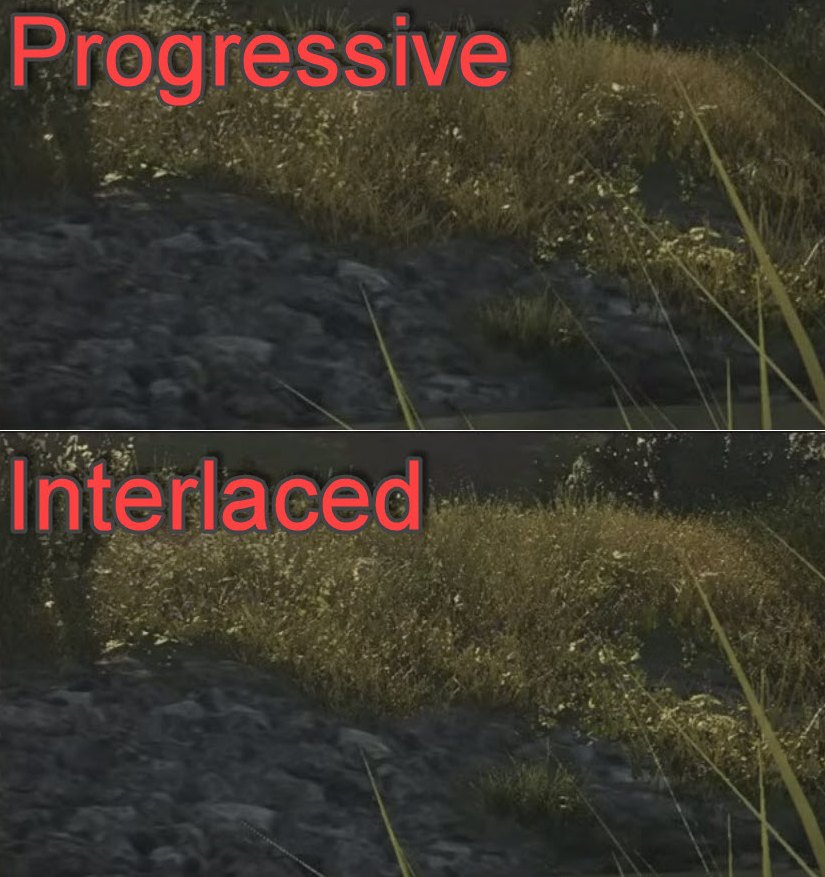
Tip: If you’re using an upscaler like FSR or DLSS, I recommend first setting Rendering Mode to Interlaced and then turning on the Upscaler. This is because turning on the Upscaler option locks out the Rendering Mode option; however, even then the setting takes effect in-game.
There are two Rendering Modes in Dragon’s Dogma 2, Progressive and Interlaced. Progressive looks better between the two as the textures look smoother. However, it takes up a lot of resources to work hence using interlaced is a better option here since we want performance as well.
Image Quality: 50%
If you’re using an upscaler then you don’t need to worry about setting up Image Quality. However, if you aren’t using an upscaler then I recommend turning the Image Quality slider to 50% first and then increasing or decreasing it until you find a sweet spot between visuals and performance.
Ray Tracing: Off
Ray Tracing takes a huge chunk off your in-game performance. I recommend only using it if your main goal is to prioritize visuals over performance.
Ambient Occlusion: SSAO

For AO, I recommend using the SSAO option. You can also use SDFAO as it also doesn’t take up a lot of resources but I found SSAO to be visually sufficient.
Anti-aliasing: TAA + FXAA
If you’re using an upscaler, then the Anti-aliasing option will be locked out for you. However, if you don’t prefer to use an upscaler then I recommend using the TAA + FXAA option as it looks best among all options (in my opinion).

Screen Space Reflections: OFF
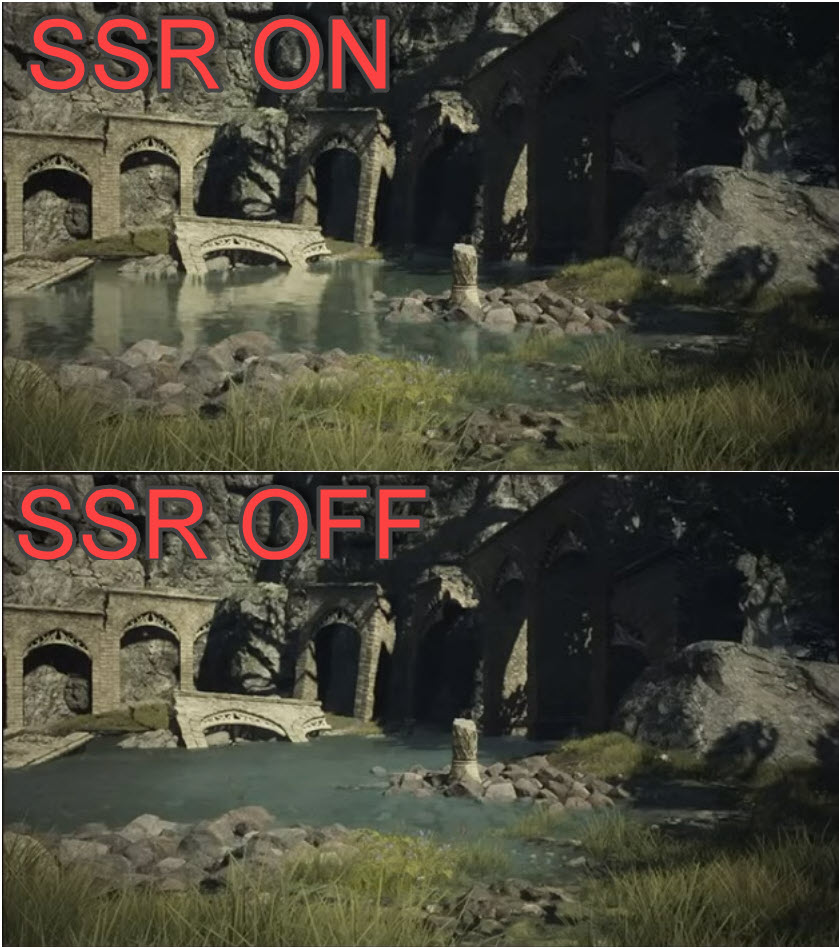
Reflections put quite a heavy load on your GPU as it adds a mirror-like layer onto shiny objects and surfaces. These take a significant portion of your performance and should be turned off unless your GPU can handle it.
Mesh Quality: Mid
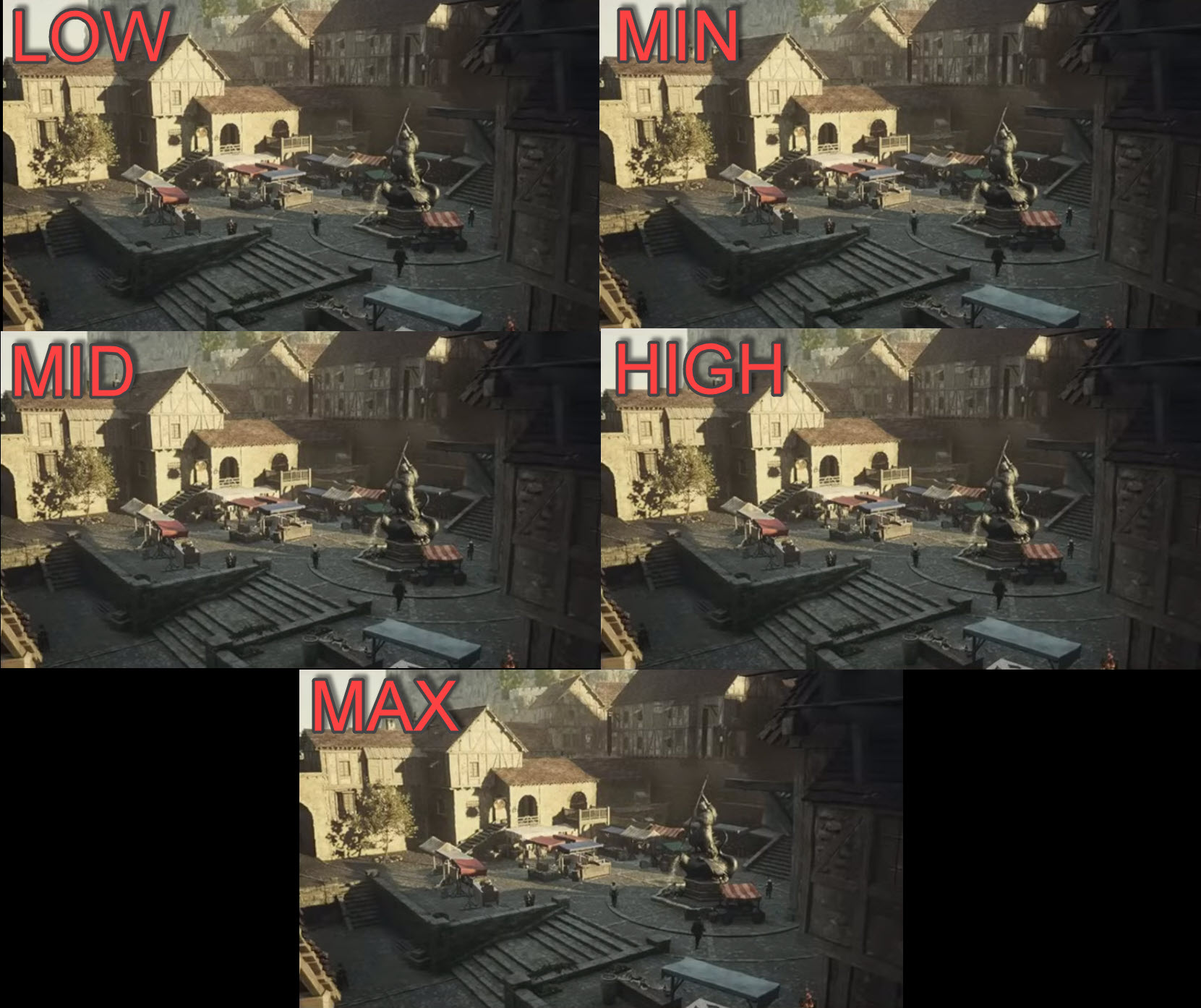
Mesh Quality isn’t that demanding in Dragon’s Dogma 2 and Mid preset is a perfect sweet spot between visuals and performance. However, you even can pull off the High preset if slightly lower performance isn’t an issue for you.
Texture Filtering: High (ANISO X8)
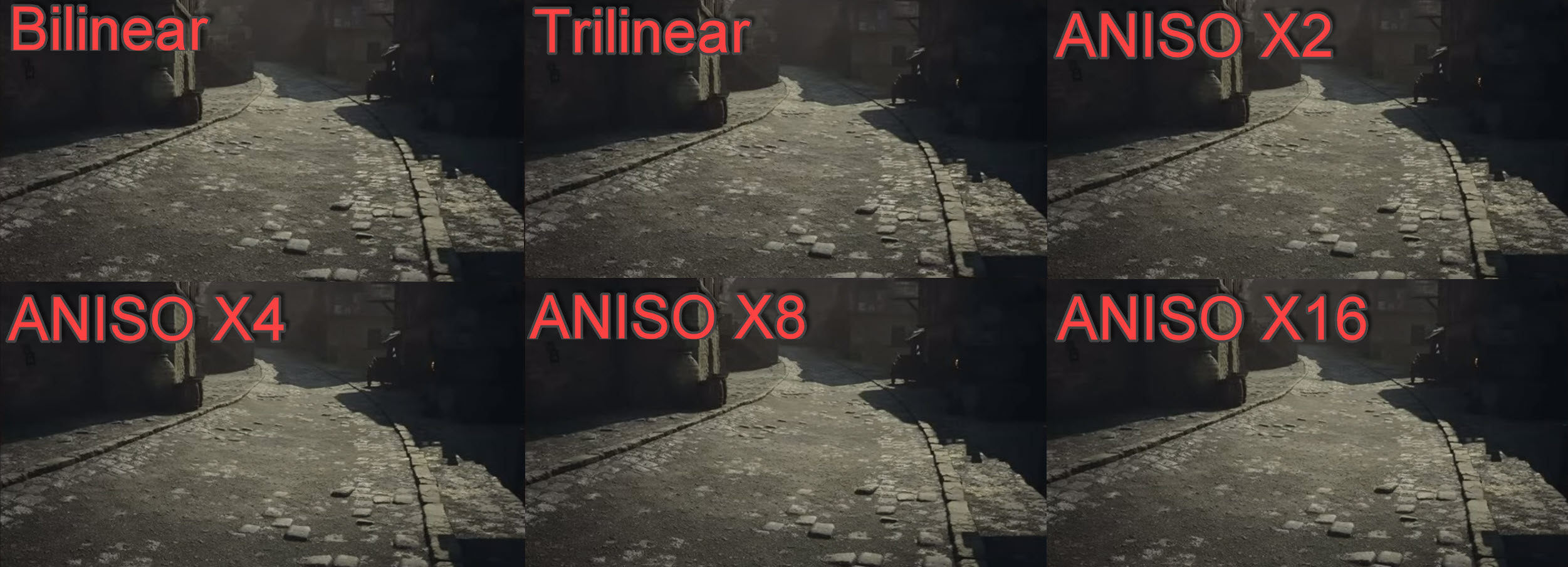
Texture Filtering is surprisingly taxing in DD2 as using ANISO X16 took a huge chunk off my game’s performance. I would generally recommend ANISO X4 or ANISO X8 as they both look great.
Texture Quality: High (1 GB)
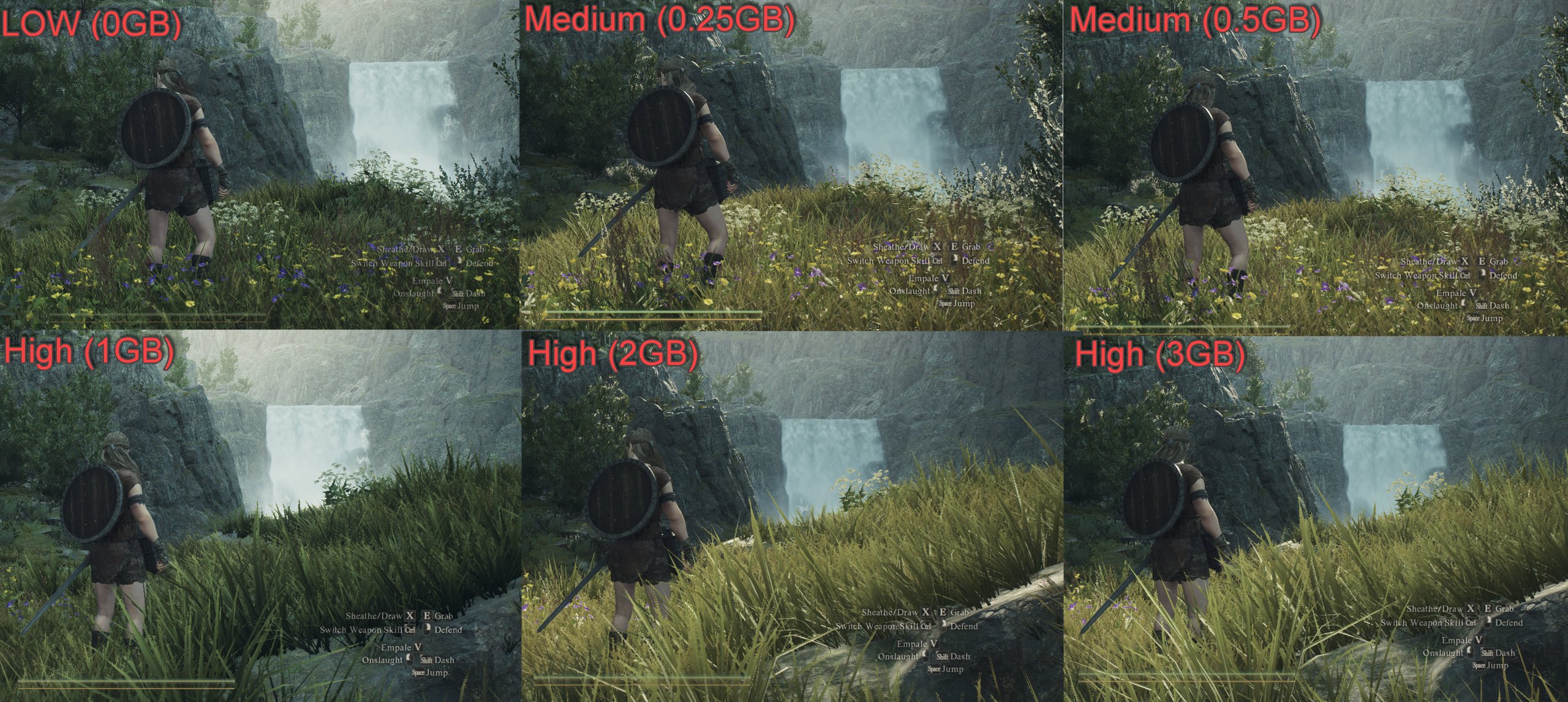
Texture Quality will control the visual quality of the in-game objects. You’ll have to keep your VRAM in consideration before cranking this setting up as going overboard may cause severe frame drops or even crashes. High (1 GB) will work for most players out there. If you’ve got VRAM to spare, feel free to increase it.
Grass/Tree Quality: Low

I didn’t really notice much difference in-game between low Grass/Tree Quality and High. However, there was a difference in frame rate by a 3-4 margin. Hence, I recommend Low Quality here.
Resource-Intense Effects Quality: High
Several effects in the game like combat and fire rely on these Effects settings. Setting it to low diminishes the effects entirely and it’ll impact your experience with the gameplay. Hence, High is the option to go here.
Shadow Quality: High
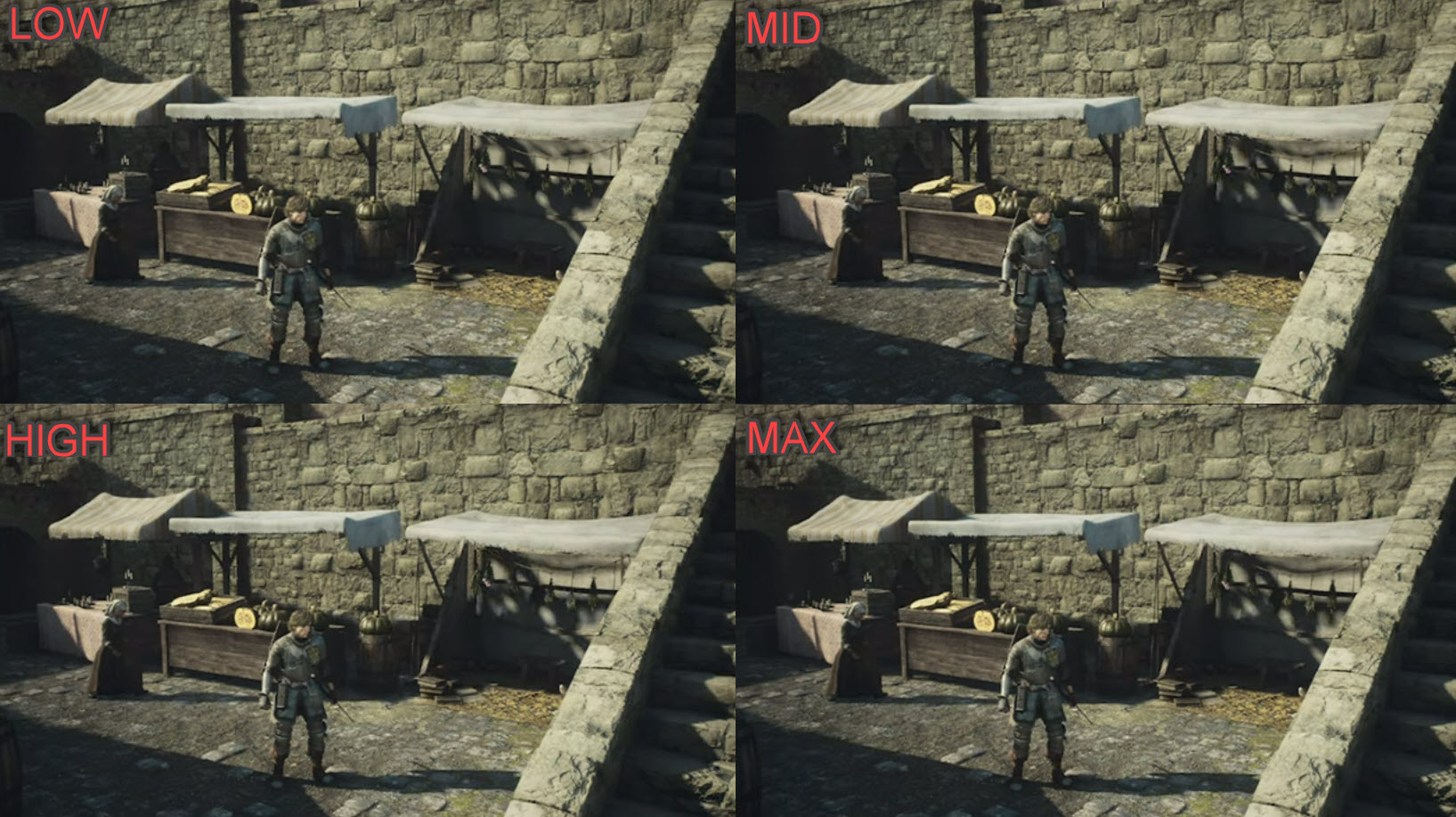
It takes a whopping 1GB of VRAM going from Low Shadows to Max. From my testing, Mid was sufficient for me but for an extra 130MB, you can choose to go with High Shadows which look much more natural.
Shadow Cache: ON
If you want to avoid stuttering or FPS dips in-game caused by Shadows, I recommend keeping Shadow Cache On.
Contact Shadows: ON
Contact Shadows is a setting that has minimal impact on your in-game performance but adds a lot of depth and detail to in-game shadows.
Motion Blur: OFF
Motion Blur doesn’t negatively impact your in-game performance but just looks awful for my taste. You’re free to leave it On if you prefer its look.
Bloom: ON
Bloom really amps up the look of objects in-game under direct lighting. For my taste, I left it at On. But, some might now prefer this so you can save an FPS or two by leaving it at Off.
Depth Of Field: ON
Depth Of Field is also a post-processing effect that some players might prefer and some won’t. I personally like the way it adds a Bokeh effect during conversations with NPCs.
Lens Flare: OFF
Lens Flare acted more like a distraction for me rather than a visually enhancing effect. I chose to leave this Off.
Lens Distortion: ON + Chromatic Aberration
I didn’t really find any performance difference, no visual difference between Off and On for Lens Distortion. It’s supposed to add a curve effect at the edges of the player’s camera that I’ve failed to notice in normal gameplay.
Subsurface Scattering: OFF
Subsurface Scattering really enhances the look of soft textures in-game, especially the character’s skin. However, the FPS cost was a bit too much for a minor visual upgrade hence I recommend leaving it Off.
Motion Quality: Low
Motion Quality controls the in-game object movement animation Quality and I didn’t really notice any major differences between Low and High. I recommend using Low to save some load off your CPU.
Winding Up Dragon’s Dogma 2 Settings Guide
Although Dragon’s Dogma 2 was released as a bad port on PC, the settings I’ve mentioned above will make your experience much more enjoyable.
As of right now, there are tons of players on forums such as Steam, Reddit, NeoGaf, and GiantBomb. There’s a mixed bag of players and the majority of them are having issues with the performance, most specifically with the CPU utilization.
The developers are aware of the performance issues in the PC port of Dragon’s Dogma 2 and they’re actively trying to improve it.
On a lighter note, (According to an IGN Tweet) Capcom has acknowledged that the frame rate drop issue is linked to CPU requirements from the NPCS. This has led players on a path to mass slaughter just to save a few FPS along the way.
Capcom told IGN that performance issues with the PC version of Dragon’s Dogma 2 may be linked to the heavy amount of CPU demanded from NPCs in the game. Now, in response, fans are plotting an NPC murder spree in a bid to boost the frame-rate. https://t.co/Tby7x4HzBJ pic.twitter.com/0OEqis5l3V
— IGN (@IGN) March 21, 2024
So as of right now, I recommend sticking to the recommended settings and tweaking them according to your liking. You may need to make slight visual compromises if you want a smooth experience with the game.
In addition to the settings, I also recommend that you increase the priority of the Dragon’s Dogma 2 process in the Task Manager to avoid FPS drops or crashes.
If you want to improve your performance even more, check out eXputer guides on Best Nvidia Settings, Most Optimized AMD Settings, and Windows Optimization guide.
Thanks! Do share your feedback with us. ⚡
How can we make this post better? Your help would be appreciated. ✍
The game runs like Crap to begin with. Yes, the optimizations helped a little bit but it needs a serious performance pass before it is playable on majority of PC builds.
